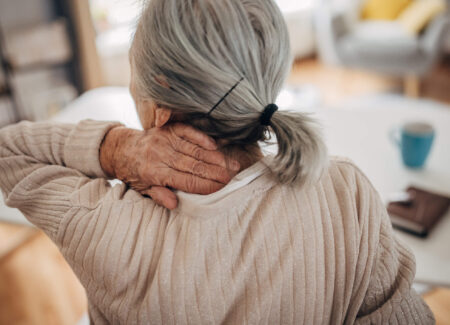
Medically reviewed by Misty Seidenburg
For many people, cold weather is more than inconvenient; it causes a very real increase in pain. If you’ve noticed an increase in pain during the colder months of the year, you should consult with a qualified healthcare professional to help address pain you’re experiencing.
Whether you have a chronic condition, a long-standing orthopedic problem, or just the aches and pains that come with aging, cold weather can magnify the associated pain. But why? It is unlikely that there is a singular cause but rather several contributing factors that may cause you to hurt more when it’s cold outside.
A quick internet search reveals many proposed causes: barometric pressure, a decrease in muscle and tendon elasticity with decreased temperatures, decreased blood flow to the joints, and even seasonal affective disorder. There are many things that could potentially cause an increase in pain during the colder months of the year, including how the nervous system may function.
Learn more about the nervous system and see how physical therapy can help you address those aches and pains all year round, not just during those colder months of the year.
The nervous system is a very complex system. The entire nervous system consists of nerves that sends signals to various parts of the body. It is broken down into two parts: the central nervous system (CNS) and the peripheral nervous system (PNS). The central nervous system is comprised of the spinal cord and brain- these are the decision makers. The peripheral nervous system is made up of all of the nerves that attach to the spinal cord. These peripheral nerves serve as the transportation system between our body and brain. Both parts operate similarly, as the general function is to communicate to different parts of the body and gauge its interactions with the world around it. Think of it as the body’s own information superhighway – it carries and processes every sensation that we experience.
The peripheral nerves act as the gateway for sensation. If the peripheral nerves functioned as an all or nothing method for all information, everything that happened to and around us would be carried to our brains for processing all of the time. That amount of constant information and stimulation would be too much for our brain to handle. Instead, our nervous system functions on more of a threshold system. So, the brain determines how sensitive the peripheral nerves need to by before the information is transmitted to our brains for processing.
Our bodies even have a way of accommodating or fine-tuning that threshold. Think of it this way: When you put pants on in the morning, you are aware that they are on and how they feel. You notice quickly whether they are soft, or the material is coarse. You sense whether they are tight or loose.
In a short period of time, your nervous system accommodates to those sensations, and you move about your day without being constantly aware of how your pants feel. So, in effect, your nervous system raises the threshold of stimulus required for you to sense that your pants are even there. Even though the fabric texture nor the fit has changed, you are no longer aware of the sensation.
When the sensation, or input, exceeds the threshold, signals are transmitted to the brain for interpretation.
Back to our pants example: Let’s say you put on a pair of light, loose-fitting pants. You quickly accommodate to the sensation and are barely aware of wearing them. Now, you walk outside, and the wind is blowing. The wind makes your loose-fitting pants flap back and forth against your legs. You now are more aware of what your pants feel like, right?
The fit and texture of your pants plus the movement created by the wind result in a stimulus that exceeds your peripheral nervous system’s threshold, thus sending a sensation (or maybe several) to your brain. Your brain then interprets this activity as the sensation of your pants against your skin.
Sensory input or activity can vary greatly during the colder months of the year. If you jam your thumb, you immediately exceed your nervous system’s threshold, sending an impulse to your brain that is quickly interpreted, “Ouch!”
Cold weather may serve as that additional input. If you have an arthritic joint, fibromyalgia, or other various conditions, your nervous system may already be sensitized, meaning it will take less stimulus to exceed your threshold. Various things can add to that level of sensitivity — cold temperatures, for sure — and combine to exceed the threshold that results in your brain interpreting the sensation as pain.
Assuming that you can’t pack up and head to the Caribbean, there are simple techniques that can help to “down-regulate” or control the activity of the nervous system during colder months of the year. This could help to decrease pain any time of year but most certainly could be effective during those frigid months.
When faced with these various pains, it is very important to talk to your doctor for further clarification and relevant next steps.
In the meantime, there are a few things that you can do! The pain in your joints can be lessened by keeping your body warm. Doing so can promote circulation and reduce potential stiffness. Another way to lessen the pain is to engage in regular exercise.
Before beginning any exercise or stretching routine, you should consult with a qualified healthcare professional or physical therapist who can help educate you on the ways to perform exercises.
Sticking to an exercise routine with activities like walking, swimming, biking, and yoga can help with supporting your joints.
In addition, try to implement some stretches before going outside. This will allow your body to ease into the increased movement as you step outside. Consider bundling up as well and wearing multiple additional layers to keep warm. Make sure to consume a healthy diet and drink plenty of fluids to stay hydrated.
Infusing these habits into your day-to-day living not only helps to maintain your weight and improve your joint pain, but it can also promote a healthier and active lifestyle.
Another thing you can do is to be proactive in addressing those aches and pains with physical therapy. Physical therapy can help you address the underlying cause of pain and help you improve function, increase activity levels, and improve mobility.
If your pain worsens or you experience new symptoms, you should consult with a qualified healthcare professional.
Our physical therapists are committed to delivering care that is personalized to you. Learn more about how physical therapy can help you address those aches and pains by requesting an appointment at a local physical therapy clinic.

